Traditional and non-standard methods of growing potatoes
Almost every gardener grows potatoes on his site. It is a favorite vegetable of Russians and the most adapted garden culture. However, not everyone can boast of a rich harvest of large, even potatoes. This is often associated with unsuccessful weather conditions, pests, and poorly purchased seed potatoes.
Few people know, but to plant potatoes can be done in many ways. If you take a chance and try another, unusual method, you can significantly increase the yield.
Content:
- Traditional methods: smooth planting, ridged planting, in a trench
- Dutch method of growing potatoes
- Growing in straw and barrels
- Growing in mounds
- Growing potatoes under plastic
- Meatlider and Gülich method
Traditional methods: smooth planting, ridged planting, in a trench
Traditional planting methods potatoes are similar to each other, but differ in preparation and in some details. It is necessary to select this or that method taking into account the soil and growing conditions. With the right selection, you can get a richer harvest at a lower cost. Traditional methods of growing potatoes are familiar and familiar to most gardeners.
Their essence lies in the fact that holes are dug in a row on the site, and then 1-2 tubers are placed in the holes and sprinkled with earth.
Such methods can be very effective in terms of yield, but they are not suitable for every plot and not for every potato. As a rule, planting in such cases is carried out very close, the rows of potatoes are dense. Individual bushes interfere with each other, he does not receive enough nutrients and light.
For this reason, it is worth following some landing rules:
- You don't need to make the holes as close to each other as possible. You won't be able to grow more potatoes... The distance between the holes should be at least 30 cm, and the holes themselves should be at a distance of 60 cm from each other.
- Loosen the aisles carefully so as not to damage the roots.
- Small tubers do not need to be planted deep in the soil. Medium tubers are planted to a depth of 10-12 cm, and small ones - 5 cm.
On waterlogged and dense soils with difficult air exchange, it is advisable to use the ridge method of growing potatoes. It consists in the fact that low ridges are made in a row (no more than 15 cm). About 70 cm of space should be left between the rows so that landing was not too frequent. Tubers are planted on these ridges. This method is convenient for large areas, fields, especially if you have a tractor.
If the soil, on the other hand, does not hold moisture well, contains a large amount of sand, it is better to plant in trenches. To do this, you need to dig a shallow trench, no deeper than 12 cm. Its depth will depend on the size of the tubers. It is better to plant tubers at a distance of at least 20 cm from each other. You cannot use this method on waterlogged soils, because the potatoes will start to rot.
Dutch method of growing potatoes
In order for the harvest to be rich, it is advisable to buy different varieties of potatoes. On one site, 2-3 varieties of potatoes can be planted.Dutch varieties are very popular due to their high yield and resistance to various diseases.
Among the Dutch varieties, the most popular are Eba, Mona Lisa, Cleopatra, Asterix.
Growing potatoes using Dutch technology allows you to increase the amount of the crop. This method has been used by our gardeners for a long time.
The Dutch method implies not only a certain type of soil cultivation, but also a number of procedures that must be carried out at a certain time:
- The Dutch pay a lot of attention to air exchange, saturation of the soil with oxygen. Therefore, before planting, the site must be thoroughly loosened.
- There should be a fairly large distance between the rows of potatoes. Thus, each bush will receive a sufficient amount of light and nutrition. The distance between the tubers when planting is at least 30 cm, and between the rows - more than half a meter.
- Choose only quality seeds. It is desirable that the seed tubers are not lower than the second reproduction (the stage of cultivar renewal). If the same seed tubers are planted annually, the yield will decrease and the potatoes will begin to accumulate infection.
- Try to change the place for potatoes every year. In the same area, potatoes will grow well if they are planted there no more often than once every three years. During the break, it is good to plant cereals on the potato plot.
- Be sure to fertilize the soil. During the spring preparation of the soil, add urea to it, and wood ash into the holes when planting.
- The Dutch recommend keeping the tubers warm before planting so that the sprouts reach a length of 2 cm.
- Cut tubers are planted. Each piece should have a peephole.
- When sprouts appear, they are removed weeds, and the bushes themselves are sprinkled with loosened earth so that the height of the ridges increases.
- Water the potatoes abundantly at least 3 times over the summer.
Subject to all the rules and the correct selection of potato varieties, you can get up to 2 kg of harvest from a bush.
Growing in straw and barrels
Unusual methods of growing potatoes will help to cope with problems such as an overgrown area (if it is not possible to plow it), lack of space on the site, and consistently low yields with traditional planting methods. In these cases, gardeners resort to the most non-standard solutions. The essence of the method of planting under straw is that the tubers are sprinkled with straw instead of soil.
This method has advantages and disadvantages. The advantages include the lack of weedsthat just can't get through the straw, a rich harvest, good air exchange and an incredibly easy harvesting method (no digging required). However, there are also some disadvantages. For example, straw does not hold water, so you will have to water a little more often. Also, straw can attract various pests, such as mice.
Growing results in straw may vary from region to region. The method of planting under the straw is suitable for those who have too heavy soil in the area or too much grass, which there is no time and opportunity to dig up. Instead of straw, it is sometimes recommended to use freshly cut grass, if by the time the potatoes are planted, it has already grown in sufficient quantity. For better moisture retention, tubers can be planted in shallow pits, and then sprinkled with straw.
It is believed that in a single barrel without a bottom, you can grow a fairly large amount of potatoes using only 4 seed tubers.
This method is suitable for those who do not have a lot of space on the site.
To grow potatoes in a barrel, you need:
- Pour 20 cm of fertile soil onto its very bottom.
- 4 tubers with eyes are placed on top and sprinkled with a small amount of soil.
- When the sprouts hatch, as they grow, you need to add earth.
- From time to time you need to water the soil and fertilize her.All procedures are performed until the barrel is full.
If you believe the inventors of this method, then closer to autumn you need to overturn the barrel and it will be full of selected potatoes. In this way, potatoes can be planted not only in a barrel, but also in a box without a bottom, a bag and even an old bucket. Some make holes in the side of the container and plant the tubers there.
Growing in mounds
With the cultivation method potatoes in the mounds, instead of the usual trenches with holes, small embankments are made. For this:
- A part of the site is separated with a circumference of about 2 m.
- Potatoes are planted along this circle so that the distance between the tubers is at least 25 cm.
- Then the planted tubers are sprinkled with earth.
- When the first shoots appear, as they grow, the earth is gradually filled up, forming a mound.
- In the end, a mound with a height of about 40 cm is obtained. Weeds, which will break through, must be removed.
The barrow method allows you to grow a large amount of crops in a small area of the site. If, after all attempts to grow a good harvest in this way, it is still possible to collect no more than half a bucket from one mound, it is worth changing the structure of the embankment. By itself, the mound does not absorb water very well; even rain streams will simply roll off it. For convenience, experienced gardeners make a small depression in the middle of the mound, into which water is poured during glaze.
All fertilizers, especially mineral, potash, must be applied to the soil before planting. It is sometimes useful slightly spud mounds to improve air exchange. If you want to get the maximum yield with this growing method, you need to plant the tubers so that each bush with one base is in the watering hole.
Growing potatoes under plastic
The method of growing potatoes under film is extremely simple. To do this, you only need a black bar or any black non-woven material. First, the site is carefully prepared for planting: it is dug up, fertilized. On the prepared area, the film is spread and fixed firmly enough so that the wind does not carry it away. Small cross cuts are made in the film canvas in rows.
A small hole is made under each cut, into which the tuber is planted and covered with earth.
This method is good in that you do not need to weed and huddle the area. It is convenient to plant early potato varieties under the film, since the black film warms up the soil faster and allows the potatoes to emerge earlier. However, it is not recommended to plant under a film potatoes in areas that are too hot and dry, the tubers will simply bake under a film and will not sprout.
Meatlider and Gülich method
Meatlider method suitable for those gardeners who do not have large areas or want to collect as much harvest as possible from each garden bed:
- First, carefully prepare the site: remove all obstacles to light, dig in, remove weed roots.
- After preparation, the markup is done. It is necessary to take a thin rope and pegs, drive the pegs on 4 sides of the garden so that there is sufficient distance between them. You should get beds up to 9 m long, up to half a meter wide, and the distance between the beds should be at least a meter.
- According to the markings, you need to dig up the beds, making small bumpers along the edge, and add fertilizer... There is no need to touch the aisles.
- Then holes are made in the beds. For better growth, the holes should be staggered at a distance of at least 30 cm from each other (meaning holes in one row, as a result, 2 rows of holes are obtained on 1 bed).
- In each hole about 10 cm deep, you need to put a little fertilizers and 1 tuber each, and sprinkle with earth on top.
The Meatlider method does not imply hilling, but watering, weeding and feeding required. The bushes need to be watered regularly so that the soil does not dry out.
Narrow beds significantly reduce maintenance and provide the shrubs with adequate nourishment while also saving space and water.
The Gühlich method is somewhat the opposite of the Mittleider method, since its essence is to provide each potato bush with as much free space as possible.
Gülich's method:
- The plot is divided into squares 1 by 1 meter.
- Inside, a roller is made of manure and one tuber is planted with its upper part in the soil.
- Shoots begin to grow from the tuber to the sides, each of which is sprinkled with earth.
- As the shoots grow, they continue to sprinkle them with soil.
- After all the manipulations, a large multistage bush is obtained, which as a result can produce up to 16 kg of potatoes, if provided with sufficient care, watering and feeding.
More information can be found in the video.




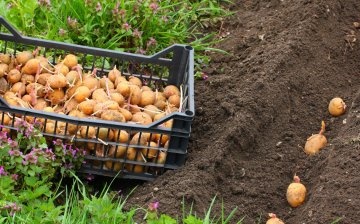

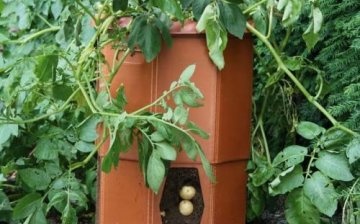
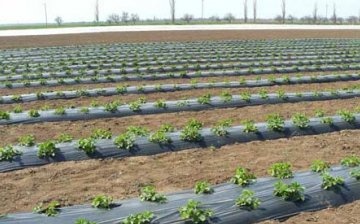
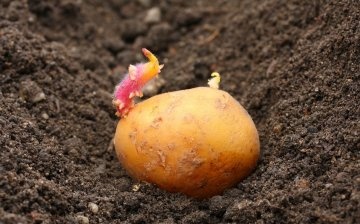
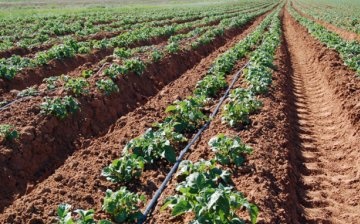







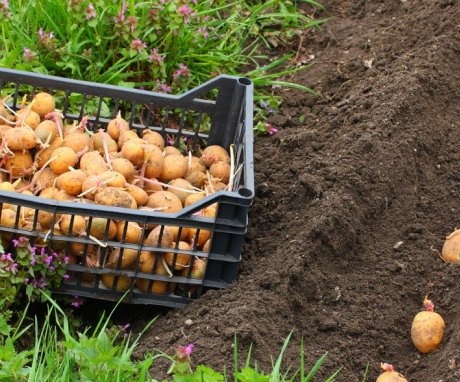
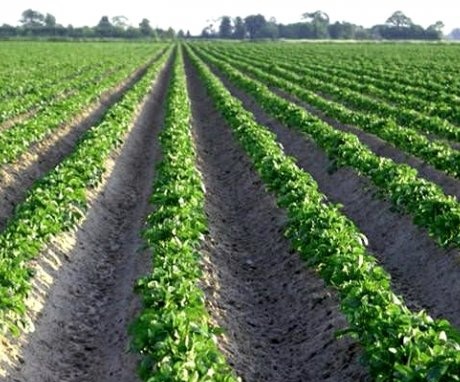
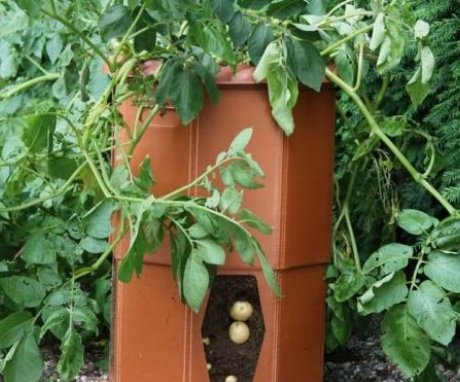
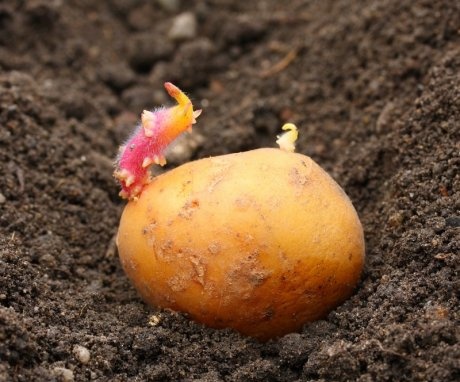
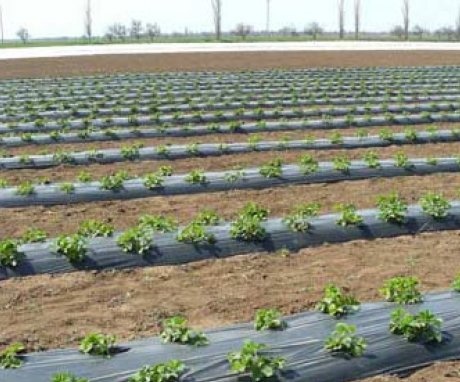
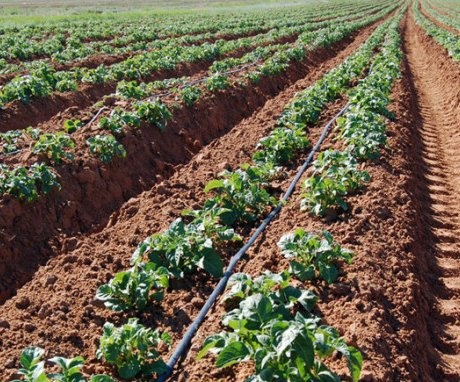
I am an advocate of the traditional cultivation of smooth planted potatoes. Once I tried to grow potatoes in a barrel, nothing happened, there were a lot of tubers, but they are all very small.